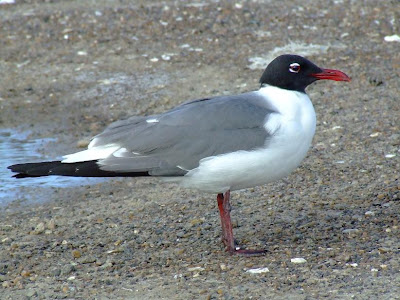
As I excitedly boarded my plane bound for Texas, I thought of all the birds I was to see in the next several days. The day had started off ordinarily enough; we had to leave for LAX at some ungodly hour of the morning, and the only bird I had for the day was the persistently singing Northern Mockingbird outside my window while I was trying in vain to sleep. That was to change soon!
The flight to Houston Hobby was uneventful. We flew over the Californian mountains and deserts, over the Arizonian mountains and deserts, over the New Mexican mountains and deserts, and over the Texan hills and deserts. The plane did fly almost directly over the north end of the Salton Sea, which was interesting.

I found my way to the gate where my connection was due to leave in the Houston Hobby Airport. I joined my teammate Hope Batcheller (code name: Hop) in looking for birds out the airport window. She was desperate to see a Scissor-tailed Flycatcher, but the only birds we saw were European Starlings, Great-tailed Grackles, and Cliff Swallows. Exciting. Our connection finally came in and an hour later we were wandering through the tiny airport at Harlingen.
We met our teammates Saraiya Ruano (code name: Ray) and Nico Sarbanes (code name: Bunting Boy) around the baggage claim, along with our mentors/drivers/temporary parents, Jeff Gordon (code name: Number One) and Liz Gordon (code name: Leica Mom). We loaded up our luggage in the waiting van and took off. I immediately noticed two strange things about driving in Texas: the roads are narrow and straight, and the traffic lights are horizontal!

As we headed towards South Padre Island, we started finding birds. My first lifer was a Golden-fronted Woodpecker that swooped across the road right in front of the van in Harlingen. We stopped at Marci and Terry Fuller's house San Benito nearby. Here, while wandering their wonderful yard, I found four more life birds: Buff-bellied Hummingbird, Great Kiskadee, Black-crested Titmouse, and Long-billed Thrasher. We saw many other interesting birds here, including Brown-crested Flycatcher, Black-bellied Whistling-Duck, and Couch's Kingbird. Unfamiliar, tropical-sounding bird calls echoed through the woods and utterly confused me. I had spent considerable time studying bird calls beforehand, but first-hand experience can't be beaten.
On our way to South Padre Island, we swung through Brownsville. Number One spotted some Green Parakeets zipping through the air, so we hastily stopped and quickly found them investigating cavities in a nearby building. Here is a shot of the team enjoying the parakeets (left to right: Number One, Bunting Boy, Leica Mom, Ray, and Hop):

Route 48 to Port Isabel and South Padre Island produced many species of birds. I saw four lifers: Mottled Duck, White-tailed Hawk, Crested Caracara, and Wilson's Plover. Shorebirds and terns were common. It was very tempting to linger and enjoy all the water birds, but Number One urged us on towards South Padre Island. Laughing Gulls were annoyingly abundant, but I enjoyed seeing this species that rarely visits California.

Our first stop on South Padre Island was a little brushy lot known as Sheepshead. As soon as we walked up, it was evident that birds were everywhere: waves of brilliant Indigo Buntings, Baltimore Orioles, and Rose-breasted Grosbeaks fluttered into the brush. Numbers of migratory eastern species were present, including Magnolia Warbler, Northern Waterthrush, Summer Tanager, and a lone female Painted Bunting, a life bird for me (sorry Chris!). A cute male Magnolia Warbler flitted through the weeds just feet away from the edge of the road.

Number One finally managed to pry us away from the scene with promises of even more birds at another woodlot a couple miles up the road - the South Padre Island Convention Center, known to birders simply as "the center". He was right; as we were pulling up an after second-year male American Redstart flashed across the road. I looked with disbelief at the tiny patch of brush nestled against a wall of the center; could this minuscule patch of plantings really be such a hot spot for migrants?

Again, the answer was "yes"! Bright eastern warblers swept through the treetops swaying in the wind, orioles of two sorts (Orchard and Baltimore) were greedily devouring grapefruit halves set out by thoughtful birders, and Indigo Buntings coated the ground by the dozens. I particularly enjoyed seeing the eastern warblers, whose faces I've missed while staring at California Gnatcatchers, Wrentits, and various shearwaters. I was especially excited to see Ovenbirds, much to the amusement of everyone else. Only Chestnut-sided Warblers cooperated for photographs; there's a second Chestnut-sided Warbler hiding behind the first one.

Number One again had to pry us away from the warblers to take a stroll down the marsh boardwalk to look for Least Bitterns. We couldn't find any, but got excellent views of Clapper Rails lurking under the boardwalk. Roseate Spoonbills, Reddish Egrets (code name: Radishes), Black-bellied Whistling Ducks, Tricolored Herons, and Sandwich Terns all flew about and foraged as the sun sank below the horizon.

Instead of turning in early as we should have done, we took a walk down the beach in the dark. The only birds we saw were a couple Sanderlings and a Willet, but we had fun catching ghost crabs. (Or rather, everyone else had fun watching me catch ghost crabs with my Yellow-crowned Night-Heron-like skills; Hop got nailed by one and Ray and Bunting Boy passed the opportunity wrestle with them.)
Coming next: May 1st, and Sabal Palms Sanctuary, Santa Ana National Wildlife Refuge, and Bentsen-Rio Grande Valley State Park!
2 comments:
Thank you for visiting South Padre Island! Come back and see us (and our birds)!
-Melissa Zamora
Communications Director
SPI Convention and Visitors Bureau
1-800-SOPADRE
www.sopadre.com
Dude there was a BLVU at Houston too. :-b Oh, wait, it was a GTGR...I can't ID those black birds, you know...
Post a Comment